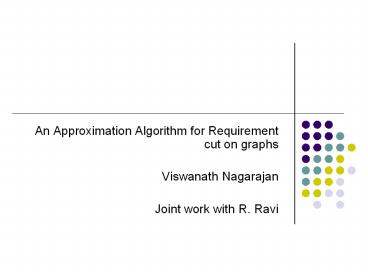An Approximation Algorithm for Requirement cut on graphs
Title:
An Approximation Algorithm for Requirement cut on graphs
Description:
An Approximation Algorithm for Requirement cut on graphs. Viswanath Nagarajan ... (t = maxi |Xi|) More examples. k-cut : 2 [SV '95] Multiway cut : 1.34 [KKSTY '99] ... –
Number of Views:93
Avg rating:3.0/5.0
Title: An Approximation Algorithm for Requirement cut on graphs
1
- An Approximation Algorithm for Requirement cut on
graphs - Viswanath Nagarajan
- Joint work with R. Ravi
2
Cut problems
- Undirected G(V,E)
- Edge costs c E ? R
- Remove minimum cost set of edges satisfying some
requirement
3
Example Multicut
- Pairs (s1,t1), (s2,t2), , (sk,tk)
- Separate each pair
- O(log k) approximation GVY93
4
Example Steiner multicut
- Groups X1, X2, , Xg µ V
- Separate each group
- O(log3 (gt)) approximation KPRT97
- (t maxi Xi)
5
More examples
- k-cut 2 SV 95
- Multiway cut 1.34 KKSTY 99
- Steiner k-cut 2 CGN 03
- Multi-multiway cut log k AL04
6
Requirement cut
- Groups X1, X2, , Xg µ V
- Requirements ri (0 ri Xi)
- Separate group Xi into ri pieces
- Generalizes previous cut problems
7
Containment of cut problems
Requirement cut
Steiner multicut
Steiner k-cut
k-cut
Multi-multiway cut
Multicut
8
Our results
- O(log n log(gR)) approximation
- n number of vertices
- g number of groups
- R maximum requirement
- O(log(gR)) approximation on trees
9
IP formulation
- min ?e2 E ce de
- s.t.
- ?e2 Ti de ri-1 8 Ti Steiner tree on Xi,
8 i1, , g - de 2 0,1 8 e2 E
10
Solving LP relaxation
- Minimum Steiner tree NP hard!
- Relax to spanning trees
- Require that d is metric
11
LP relaxation
- min ?e2 E ce de
- s.t.
- ?e2 Ti de ri 1 8 Ti spanning tree on Xi
- 8 i 1, , g
- d metric
- de2 0,1 8 e2 E
12
Requirement cut on trees
- Input graph G is a tree
- Reduction from set cover ) ?(log g) hard
- LP rounding yields O(log(gR)) approximation
13
Tree rounding
- Solve LP to get d (OPTlp ?e2 E ce de)
- Define de min2 de, 1
- Repeat O(log(gR)) times
- Pick each edge of tree G with probability de
14
Tree rounding
- Theorem Randomized rounding for requirement cut
on trees yields a solution of cost at most
O(log(gR)) OPTlp - Cost in single phase 2 OPTlp
- Total cost of rounding O(log (gR)) OPTlp
- Need to satisfy all requirements
15
Single phase
- ci current number of components of Xi
- Residual requirement of Xi ri ci
- Lemma In each phase of randomized rounding, the
total residual requirement reduces by a factor of
4/3, in expectation.
16
Bounding number of phases
- Initial requirement gR
- Expected requirement after phase k,
ERk (¾)k gR - k 4ln(gR) ) ERk ½
17
Rounding in single phase
- Current forest F
- Fi forest induced by Xi
- Hi shortcut Fi over degree 2 Steiner vertices
18
Single phase - analysis
- Removing edges of Hi new components in Fi
- Lemma Expected number of edges of Hi removed
is at least (1-1/e) d(Hi) - Here, d(Hi) ?e2 Hi de
19
Single phase - analysis
- Claim In any Steiner forest Hi with each non
terminal having degree 3, removing any m edges
results in at least d(m1)/2e new terminal
components - Expected number of new components containing
Xi (1- 1/e) ½ d(Hi) ¼ d(Hi)
20
Single phase - analysis
- Extend Hi to Steiner tree on Xi
- Add ci 1 edges
- d(Hi) ci 1 ri 1 ( Sp. tree constraint)
- d(Hi) ri ci residual requirement of Xi
21
Single phase - analysis
- Number of new components ¼ (ri-ci)
- new requirement of group Xi
- old requirement number of new components
- ¾ old requirement
- total new requirement
- ¾ total old requirement (All in
expectation)
22
General graphs
- Solve LP on G to get metric d
- Use FRT embedding to tree metric (?,T)
- (edges of T cuts in G)
- Use tree rounding on T
- O(log n log(gR)) approximation
23
Conclusions
- Introduced requirement cut problem
- O(log n log(gR)) integrality gap
- Improvement for planar graphs?
- Even on trees, gap between ?(log g) lower bound,
O(log(gR)) upper bound
24
Thank you!
25
Extra claim
- Claim Minimum Steiner tree on Xi w.r.t. d is
at least ri 1
d costs on edges
26
Single phase - analysis
- Lemma Expected number of edges of Hi removed
is at least (1-1/e) d(Hi) - (u,v) edge of Hi
- P path connecting u and v in Fi
Pµ Fi
u
v
(u,v)2 Hi
27
Lemma contd.
- Pr separating u and v 1 - ?e2 P (1-de)
- 1 e-d(P)
- A) d(P) 1
- Pr 1 e-d(P) (1-1/e) d(P) (1-1/e)
du,v - B) d(P) 1
- Pr 1 e-d(P) 1 1/e (1-1/e) du,v































